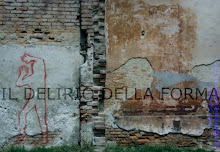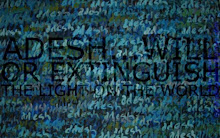
skip to main |
skip to sidebar
Nexus is a quest of an identity which has lost the image of its own resemblance. Its name is everywhere : in a cleaning company or in a computer one, its name is like a thread of connection in a multiplication of bodies of a single body, it is like a ring where neverending chances/possibilities wheel about, neverending differences ignoring of being part one of the other.
Albamuth is the sign of a distance.
The source may only be evoked and it is like a vague memory coming from oblivion, from forgetfulness. It is a message, a piece of information whose feeble impulse seems to vanish leaving its origin uncertain: it may come from a bright point in the space or from a heartbeat.
It is hard to talk about it. There are secrets you cannot reveal but betraying their own essence: you have to keep the secret even to yourself as you can be a nasty guardian of it, you have to find the right form, the most acceptable one, which by the end cannot but describe a partial, uncomplete picture. Nexus was made of pieces, each of them has its own life but they also are part of a whole and it is in this game of mirrors that you can find the completion of its representation.
Nexus was due to the necessity of integrating people in their own multiplicity, when this multiplicity is referable to every single part. It’s like moving oneself all along rings in a superimposition of states, in the search for a balance between different dimensions separately experienced, a search passing through the individual sphere that does not depend on the social and political ones and where the point of observation wanders towards an unreachable distance and, then, it comes back. The continuous movement inside the confusion of languages altering, twisting and bends continuously the normal perceptions, like a line seen from up above appears like a segment of a spiral. It is a continuous journey inside your mind, its imagination, its world made of images to be reflected in, identified.
What is reality but an image produced by a temporal dissociation? F. K. Dick wondered it in an obsessive way giving the sense of the distance of being alien inside social alienation.
Falling in the synchronous states, there happens the magic so that apparently different genres are intermingled in an only subterranean weft. Its visible trace is what you can find in a page which like a book or like a painting. So, temporal dissociation. Information are widespread and are perceived in a distorted way: you have to distinguish what is original from what is transmitted , like before or after or cause/effect, what is our from what is not, excluding the limit of an inadequate language. All around it, the identity has to be rebuilt keeping the pieces together in a search that not only argue the Egoica vision from an individual point of view, but also the idea of the Artist and of copywright.
There is nothing that is either original or belongs to collectivity, of course, without excluding the obvious contradiction such an issue may rise. The difficulty is to understand the differences between what it really does not belong to/ goes beyond us and what is made following bound and prevailing patterns.
Anyway, in art there is nothing left but what is sifted, whatever expresses a synthesis.
Passing through recyclings any fragments in the refuse disposal site may be regained and get a glimmer of light on a memory.
The process is the same even using word as using matter, the origin/originality principle coincides with the faculty of passing on trying to adhere to the moment, to the contemporaneousness that is like an isle which sinks, once you have reached it.
Starting from words and writing, I would like to make it visible rather than readable and so transform it into an image, into something whose sense is not fully receivable, but it does not mean it cannot be assimilable. Word/Image, Word/Sign. Also here, necessarily this happens in a process which … Synthesis is the opposite of shattering and multiplication, synthesis must catch the best that it can and it must associate analogically all the pieces.
Being inside the story following its own end is the only way to escape the “take it and leave it” dual logic as a breath, as a heartbeat.
Testo di Aldo Saracino (Albamuth) Traduzione di John Kokko


ALBAMUTH
THE SIGN OF A DISTANCE
MANIFESTO
Nexus is a quest of an identity which has lost the image of its own resemblance. Its name is everywhere : in a cleaning company or in a computer one, its name is like a thread of connection in a multiplication of bodies of a single body, it is like a ring where neverending chances/possibilities wheel about, neverending differences ignoring of being part one of the other.
Albamuth is the sign of a distance.
The source may only be evoked and it is like a vague memory coming from oblivion, from forgetfulness. It is a message, a piece of information whose feeble impulse seems to vanish leaving its origin uncertain: it may come from a bright point in the space or from a heartbeat.
It is hard to talk about it. There are secrets you cannot reveal but betraying their own essence: you have to keep the secret even to yourself as you can be a nasty guardian of it, you have to find the right form, the most acceptable one, which by the end cannot but describe a partial, uncomplete picture. Nexus was made of pieces, each of them has its own life but they also are part of a whole and it is in this game of mirrors that you can find the completion of its representation.
Nexus was due to the necessity of integrating people in their own multiplicity, when this multiplicity is referable to every single part. It’s like moving oneself all along rings in a superimposition of states, in the search for a balance between different dimensions separately experienced, a search passing through the individual sphere that does not depend on the social and political ones and where the point of observation wanders towards an unreachable distance and, then, it comes back. The continuous movement inside the confusion of languages altering, twisting and bends continuously the normal perceptions, like a line seen from up above appears like a segment of a spiral. It is a continuous journey inside your mind, its imagination, its world made of images to be reflected in, identified.
What is reality but an image produced by a temporal dissociation? F. K. Dick wondered it in an obsessive way giving the sense of the distance of being alien inside social alienation.
Falling in the synchronous states, there happens the magic so that apparently different genres are intermingled in an only subterranean weft. Its visible trace is what you can find in a page which like a book or like a painting. So, temporal dissociation. Information are widespread and are perceived in a distorted way: you have to distinguish what is original from what is transmitted , like before or after or cause/effect, what is our from what is not, excluding the limit of an inadequate language. All around it, the identity has to be rebuilt keeping the pieces together in a search that not only argue the Egoica vision from an individual point of view, but also the idea of the Artist and of copywright.
There is nothing that is either original or belongs to collectivity, of course, without excluding the obvious contradiction such an issue may rise. The difficulty is to understand the differences between what it really does not belong to/ goes beyond us and what is made following bound and prevailing patterns.
Anyway, in art there is nothing left but what is sifted, whatever expresses a synthesis.
Passing through recyclings any fragments in the refuse disposal site may be regained and get a glimmer of light on a memory.
The process is the same even using word as using matter, the origin/originality principle coincides with the faculty of passing on trying to adhere to the moment, to the contemporaneousness that is like an isle which sinks, once you have reached it.
Starting from words and writing, I would like to make it visible rather than readable and so transform it into an image, into something whose sense is not fully receivable, but it does not mean it cannot be assimilable. Word/Image, Word/Sign. Also here, necessarily this happens in a process which … Synthesis is the opposite of shattering and multiplication, synthesis must catch the best that it can and it must associate analogically all the pieces.
Being inside the story following its own end is the only way to escape the “take it and leave it” dual logic as a breath, as a heartbeat.
Testo di Aldo Saracino (Albamuth) Traduzione di John Kokko
IL DELIRIO DELLA FORMA

Adesh... volontà, o spegnere la luce sul mondo

CONTATTI
albamuth@virgilio.it